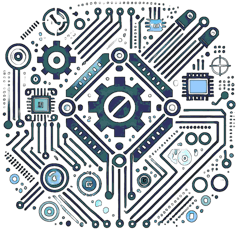Introduction
This tutorial demonstrates how to use XOR and AND gates to construct a simple digital adder circuit capable of performing binary addition. Digital adders are fundamental components in digital electronics and are widely used in processors and arithmetic circuits. Understanding how to design and test these circuits provides essential insight into digital logic.
Binary addition is performed by combining two bits at a time, resulting in a sum bit and a carry bit. This project implements the basic logic of a 1-bit binary adder.
Circuit Wiring Instructions
Follow these steps to wire the XOR-based digital adder circuit on a breadboard:
- Power Connections:
Connect the positive rail of the breadboard to the power supply's +5V output and the negative rail to GND. Verify that the power connections are secure to avoid fluctuations in the circuit.
- XOR Gate (Sum Output):
- Place the XOR gate IC on the breadboard with its pins straddling the center divider for easy access to both rows of pins.
- Connect pin 14 (VCC) of the XOR gate IC to the +5V rail and pin 7 (GND) to the GND rail.
- Wire the first binary input (A) to the XOR gate's pin 1 and the second binary input (B) to pin 2.
- Connect the XOR output (Sum) on pin 3 to an LED with a 220Ω resistor in series. This LED will indicate the sum bit of the binary addition.
- AND Gate (Carry Output):
- Place the AND gate IC similarly on the breadboard, ensuring proper alignment of the pins.
- Connect pin 14 (VCC) of the AND gate IC to the +5V rail and pin 7 (GND) to the GND rail.
- Wire the same binary inputs (A and B) to the AND gate’s pin 1 and pin 2, respectively.
- Connect the AND output (Carry) on pin 3 to a second LED with a 220Ω resistor in series. This LED will indicate the carry bit of the binary addition.
- Testing the Circuit:
Power the circuit using a 5V source. Test different input combinations (A and B) by connecting them to +5V (logic high) or GND (logic low). Observe the corresponding LED outputs for the Sum and Carry bits:
- A = 0, B = 0: Both LEDs off.
- A = 1, B = 0 or A = 0, B = 1: Sum LED on, Carry LED off.
- A = 1, B = 1: Sum LED off, Carry LED on.
No Ads Available.
Required Components
Gather the following components to build your XOR-based digital adder circuit:
- XOR Gate IC (e.g., 74LS86)
- AND Gate IC (e.g., 74LS08)
- Two 220Ω Resistors for current-limiting LEDs
- Two LEDs (any color, for Sum and Carry outputs)
- Breadboard and jumper wires
- 5V power supply (e.g., USB or battery pack)
Assembly Steps
Step 1: Prepare the Breadboard
Insert the XOR and AND gate ICs into the breadboard. Ensure each IC is firmly seated, with its pins properly straddling the breadboard’s center divider.
Step 2: Wire the Power Supply
Connect the power supply’s +5V and GND terminals to the breadboard's positive and negative rails, respectively.
Step 3: Connect the XOR Gate
Wire the XOR gate inputs (A and B) and its output (Sum) as described in the circuit wiring instructions. Use an LED and resistor for visual feedback.
Step 4: Connect the AND Gate
Wire the AND gate inputs (A and B) and its output (Carry) as described in the circuit wiring instructions. Use another LED and resistor for visual feedback.
Step 5: Test and Debug
Apply power and test the circuit. If the LEDs do not respond as expected, check the connections for loose or misplaced wires and verify the orientation of the ICs and LEDs.
Experiment
Once the circuit is operational, conduct the following experiments:
- Vary the inputs (A and B) and record the Sum and Carry outputs.
- Replace the LEDs with multimeters to measure the voltage levels at the Sum and Carry outputs.
- Use additional XOR and AND gates to expand the circuit for multi-bit binary addition.
Applications
Simple digital adder circuits like this one have a wide range of applications:
- Building more complex arithmetic logic units (ALUs)
- Learning the fundamentals of digital electronics
- Demonstrating binary arithmetic for educational purposes
- Designing basic digital logic circuits for computational tasks
Conclusion
By constructing this XOR-based digital adder circuit, you have gained hands-on experience with digital logic gates and binary addition. This knowledge is foundational for more advanced projects, such as creating full adders, arithmetic circuits, or even simple CPUs. Continue experimenting and expanding your circuit for greater challenges!


